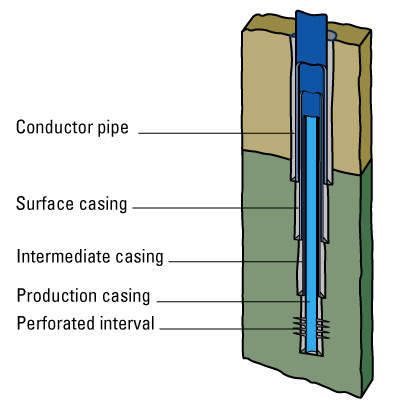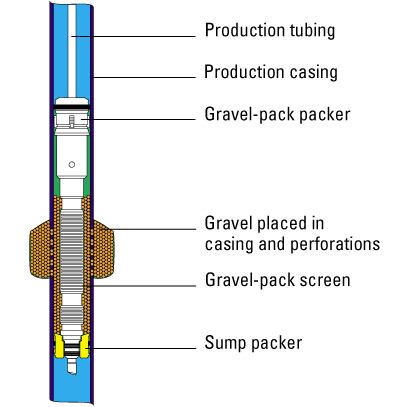How Continuous Cement Works Oil Field
Once a well has been drilled, the decision must be made: Will this well become a producer or be plugged and abandoned as a dry hole? Should the operator decide to move forward with developing the well, completion operations must be undertaken.
Well completion incorporates the steps taken to transform a drilled well into a producing one. These steps include casing, cementing, perforating, gravel packing and installing a production tree.
Casing
The first step in completing a well is to case the hole. After a well has been drilled, should the drilling fluids be removed, the well would eventually close in upon itself. Casing ensures that this will not happen while also protecting the wellstream from outside incumbents, like water or sand.
Consisting of steel pipe that is joined together to make a continuous hollow tube, casing is run into the well. The different levels of the well define what diameter of casing will be installed. Referred to as a casing program, the different levels include production casing, intermediate casing, surface casing and conductor casing.

Additionally, there are two types of casing that can be run on a well. One type of casing consists of a solid string of steel pipe. Solid casing is run on the well if the formation is firm and will remain that way during the life of the well. Should the well contain loose sand that might infiltrate the wellstream, the casing is installed with a wire screen liner that will help to block the sand from entering the wellbore.
Cementing
The next step in well completion involves cementing the well. This includes pumping cement slurry into the well to displace the existing drilling fluids and fill in the space between the casing and the actual sides of the drilled well.

Consisting of a special mixture of additives and cement, the slurry is left to harden, sealing the well from non-hydrocarbons that might try to enter the wellstream, as well as permanently positioning the casing into place.
Open-Hole Completions
At the reservoir level, there are two types of completion methods used on wells: open-hole or cased-hole completions. An open-hole completion refers to a well that is drilled to the top of the hydrocarbon reservoir. The well is then cased at this level, and left open at the bottom. Also known as top sets and barefoot completions, open-hole completions are used to reduce the cost of casing where the reservoir is solid and well-known.
Perforation
Cased-hole completions require casing to be run into the reservoir. In order to achieve production, the casing and cement are perforated to allow the hydrocarbons to enter the wellstream.

This process involves running a perforation gun and a reservoir locating device into the wellbore, many times via a wireline, slickline or coiled tubing. Once the reservoir level has been reached, the gun then shoots holes in the sides of the well to allow the hydrocarbons to enter the wellstream. The perforations can either be accomplished via firing bullets into the sides of the casing or by discharging jets, or shaped charges, into the casing.
While the perforation locations have been previously defined by drilling logs, those intervals cannot be easily located through the casing and cement. To overcome this challenge, a gamma ray-collar correlation log is typically implemented to correlate with the initial log run on the well and define the locations where perforation is required.
Gravel Pack
Some wells require filtration systems in order to keep the wellstream clear of sand. In addition to running a casing with a liner, gravel packing is used to prevent sand from entering the wellstream.

More complicated than cementing a well, gravel packing requires a slurry of appropriately sized pieces of coarse sand -- or gravel -- to be pumped into the well between the slotted liner of the casing and the sides of the wellbore. The wire screens of the liner and the gravel pack work together to filter out the sand that might have otherwise entered the wellstream with the hydrocarbons.
Production Tree
The last step in completing a well, a wellhead is installed at the surface of the well. Many times called a production tree or Christmas tree, the wellhead device includes casingheads and a tubing head combined to provide surface control of the subsurface conditions of the well.

While both onshore and offshore wells are completed by production trees, offshore wells can be completed by two different types of trees: dry and wet trees. Similar to onshore production trees, dry trees are installed above the water�s surface on the deck of a platform or facility and are attached to the well below the water. Wet trees, on the other hand, are installed on the seabed and encased in a solid steel box to protect the valves and gages from the elements. The subsea wet tree is then connected via electronic or hydraulic settings that can be manipulated from the surface or via ROVs.
Additionally, wells may have production flowing from multiple reservoir levels. These wells require multiple completions, which keep the production separate. Double-wing trees are installed on multiple reservoir levels.
Furthermore, completions have evolved to incorporate downhole sensors that measure flow properties, such as rate, pressure and gas-to-oil ratio. Known as intelligent wells or smart wells, these completions help to achieve optimum production rates.
Source: https://www.rigzone.com/training/insight.asp?insight_id=326&c_id=
0 Response to "How Continuous Cement Works Oil Field"
Post a Comment